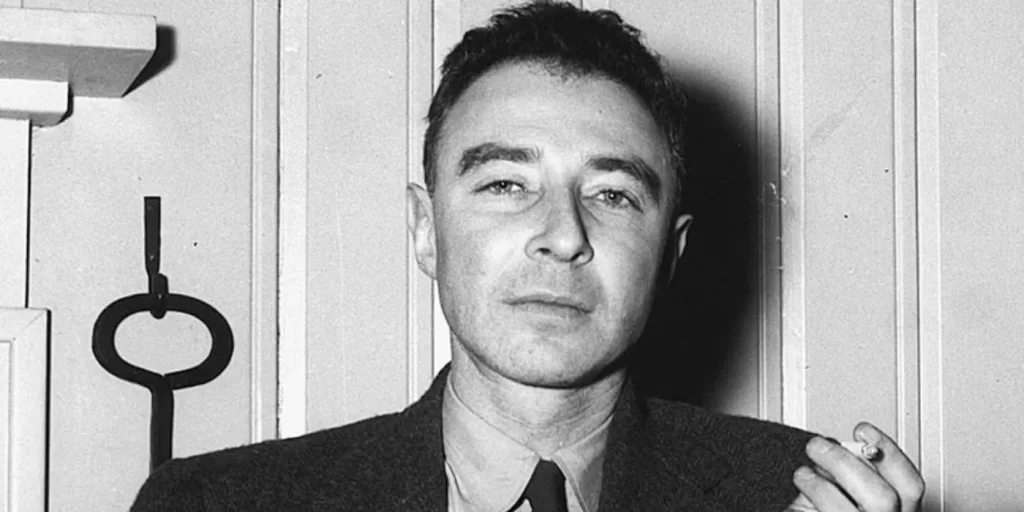J. Robert Oppenheimer was an American theoretical physicist and professor of physics at the University of California. He is best known for his role as the director of the Los Alamos Laboratory during World War II. He is often credited as the “father of the atomic bomb” for his role in the Manhattan Project, the research and development undertaking that created the first nuclear weapons.
After the end of the war, Oppenheimer became a vocal critic of the use of nuclear weapons and later became an advocate for nuclear disarmament. He was later stripped of his security clearance in the 1950s due to this opposition and his left-leaning political views. Despite this, he remained a respected figure in the scientific community and received numerous awards for his contributions to science.
Biography
J. Robert Oppenheimer was born into a wealthy Jewish family in New York City on April 22, 1904. He had his primary education at Alcuin Preparatory School and then entered the Ethical Culture Society School where he graduated in 1921. Oppenheimer joined Harvard in 1922. He initially majored in chemistry, but switched to physics. graduating in 1925. After graduating, Oppenheimer spent time at Cambridge University conducting research at their Cavendish Laboratory. His clumsiness in the laboratory made it apparent that his forte was not experimental but rather theoretical physics.
In 1926, Oppenheimer left Cambridge for the University of Göttingen, where He obtained his Ph.D. at the age of 23. While there, Oppenheimer published many important contributions to the newly developed quantum theory – most notably a famous paper on the ‘Born-Oppenheimer approximation’, which separates nuclear motion from electronic motion in the mathematical treatment of molecules.
In 1927, he returned to Harvard as a National Research Council Fellow studying mathematical physics, and a year later, studied at the California Institute of Technology. Whilst there, he also accepted a job at the University of California, Berkeley as an assistant professor. For the next 13 years, he maintained his joint roles at the two universities, commuting between them – along with many of his associates and students who followed him. Oppenheimer’s intelligence in this field was outstanding, and he became credited as a founding father of the American school of theoretical physics.
The Manhattan Project
On October 9, 1941, two months before the United States entered World War II, President Franklin D. Roosevelt approved a crash program to develop an atomic bomb. J. Robert Oppenheimer was invited by one his Harvard lecturers to take over work on fast neutron calculations, a task Oppenheimer threw himself into with full vigor.
Folllowing the establishment of the Manhattan Project, Oppenheimer was then appointed as the scientific director of the Project by General Leslie Groves in June 1942. This choice surprised many, because Oppenheimer had left-wing political views and no record as a leading of large projects. Oppenheimer oversaw the construction and administration Los Alamos laboratory, and then assembled a group of the top physicists, which he called the “luminaries. Their main goal was to harness nuclear energy for military purposes.
The joint work of these scientists resulted in the world’s first nuclear explosion, near Alamogordo, New Mexico, on July 16, 1945. The blast was the equivalent to 20,000 tons of TNT and created a fireball that reached temperatures of several million degrees. Oppenheimer had given the site the codename “Trinity”. He later remarked that the explosion brought to his mind words from the Hindu scripture Bhagavad Gita: “Now I am become Death, the destroyer of worlds.”
Read More:
- Why Japan Attacked Pearl Harbor?
- Reinhard Heydrich, Hitler’s Most Evil General
- The Horrific Deeds of Shiro Ishii and Unit 731
Hiroshima and Nagasaki
In August 1945, the atomic bombs were used on the Japanese cities of Hiroshima and Nagasaki, the only use of nuclear weapons in war. The first bomb was dropped on the city of Hiroshima Killing an estimated 80,000 people. Tens of thousands more would later die of radiation exposure. The second bomb dropped on Nagasaki, instantly killed 40,000 people and many more over time. The attacks are widely believed to have played a decisive role in convincing Japan to surrender and bringing about an end to World War Two.
Following the Hiroshima Bombing Oppenheimer noted his regret the weapon had not been available in time to use against Nazi Germany. However he was very upset about the bombing of Nagasaki, as he felt the second bomb was not necessary. He traveled to Washington on August 17 to hand-deliver a letter to Secretary of War Henry L. Stimson expressing his revulsion and his wish to see nuclear weapons banned.
In October 1945, Oppenheimer was granted an interview with President Harry S. Truman. The meeting went badly after Oppenheimer said he felt he had “blood on my hands”. The remark infuriated Truman and put an end to the meeting. Truman later told his Undersecretary of State Dean Acheson, “I don’t want to see that son-of-a-bitch in this office ever again.” For his services as director of Los Alamos, Oppenheimer was awarded the Medal for Merit by President Truman in 1946.
Postwar opposition to nuclear weapons
After the war ended, J. Robert Oppenheimer became chairman of the influential General Advisory Committee of the newly created United States Atomic Energy Commission (AEC). He lobbied for international control of nuclear power, to avert nuclear proliferation and a nuclear arms race with the Soviet Union. He opposed the development of the hydrogen bomb and took opposing stances on defense-related issues that provoked the ire of some U.S. government and military factions.
During the Second Red Scare, those stances, together with past associations Oppenheimer had with people and organizations affiliated with the Communist Party, led to the revocation of his security clearance in a security hearing in 1954. He was also stripped of of his position and direct political influence The American scientific community were shocked by the AEC’s decision, and protested his trial.
The case aroused widespread controversy in the world of science and Oppenheimer was used to symbolized the folly of scientists who believed they could control the use of their research, and the dilemmas of moral responsibility presented by science in the nuclear age. The hearings were motivated by politics and personal enmities, and also reflected a stark divide in the nuclear weapons community. On 16 December 2022, the US Secretary of Energy Jennifer Granholm finally cleared Oppenheimer of the allegations that had led to the revocation of his security clearance, citing the AEC’s ‘flawed investigation’.
Final years and death
In his Later years, J. Robert Oppenheimer was increasingly concerned about the potential danger that scientific inventions could pose to humanity. He joined with Albert Einstein, Bertrand Russell, Joseph Rotblat and other eminent scientists and academics to establish what would eventually, in 1960, become the World Academy of Art and Science.
Deprived of political power, Oppenheimer continued to lecture, write and work on physics. He toured Europe and Japan, giving talks about the history of science, the role of science in society, and the nature of the universe. In his speeches and public writings,he continually stressed the difficulty of managing the power of knowledge in a world in which the freedom of science to exchange ideas was more and more hobbled by political concerns.
In September 1957, France made him an Officer of the Legion of Honor, and on May 3, 1962, he was elected a Foreign Member of the Royal Society in Britain. A year later, President John F. Kennedy awarded him (and Lyndon B. Johnson presented him with) the Enrico Fermi Award as a gesture of political rehabilitation.
Oppenheimer who was a chain smoker through out his life, was diagnosed with throat cancer in late 1965. After inconclusive surgery, he underwent unsuccessful radiation treatment and chemotherapy late in 1966. He fell into a coma on February 15, 1967, and died at his home in Princeton, New Jersey, on February 18, aged 62.





